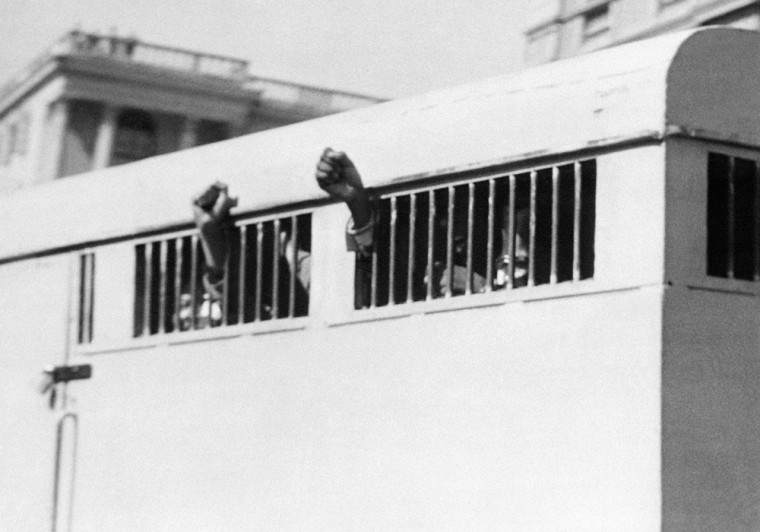
All week long, the tributes have soared for the man who South Africans say created their country, but an important chapter seems to have gone largely missing from the testimonials.
This “giant of history” was compared to Mahatma Gandhi, Martin Luther King Jr. and even Jesus Christ – often wrapped into one.
But only a few, like Jacob Zuma, South Africa’s current president and himself a former militant, touched on Mandela’s controversial embrace of violence and his plan to topple the apartheid regime through a campaign of potentially lethal sabotage.
“To him,” Zuma said during the large memorial service in Johannesburg on Tuesday, “for South Africa to attain peace, the armed struggle was inevitable, but it was a means to an end but not an end in itself.”
Not part of the ‘saintly’ image
But some South Africa experts say there’s a clear reason why the details of Mandela’s freedom fighting have been largely airbrushed out of the memorializing.
“If you were to ask, was the armed struggle an essential component to the defeat of apartheid, the answer would have to be ‘yes.’ One that doesn’t sit comfortably with the saintly images the media wish to portray,’’ said Wayne Dooling, Professor of History at the University of London’s School of Oriental and African Studies.
Many argue that the Sharpeville massacre on March 21, 1960, when police opened fire on a peaceful protest in a black township killing 69 people, was the turning point when black resistance went from a non-violent campaign to an armed resistance movement.
Mandela, far from remaining a passive, non-violent activist, became the first commander in chief of the African National Congress' military wing, called the “Umkhonto we Sizwe,” or “Spear of the Nation,” (and better known as “MK” - the South African version of the IRA) after Sharpeville.
Inspired more by the writings of Mao Zedong and Che Guevara than Gandhi, Mandela built up from scratch a small insurgent force, trained in blowing up easy targets, like electricity transmission towers and rail lines. His recruits learned to make primitive bombs from ingredients normally found on South African farms.
The ‘Black Pimpernel’
By 1962, Mandela was already an underground “terrorist,” wanted by the police and living an outlaw existence who the media had dubbed the “Black Pimpernel” — a twist on the fictional “Scarlet Pimpernel” who struck at will and, Zoro-like, always avoided capture.
That year, according to multiple historical accounts, he made a secret, six-month-long trip to a dozen African states, seeking political support and money from other African revolutionary armies. He returned to South Africa with about $30,000 in funds and a revived enthusiasm for guerrilla warfare.
He even underwent his own military training, having spent weeks on the firing range and perfecting his explosives skills in Moroccan and Ethiopian military camps. The night before his arrest on charges of treason and sabotage, Mandela was reportedly seen at a party in Durban proudly sporting khaki fatigues, with pistol at his side.
“He openly talked about the necessity to move toward guerrilla warfare,” wrote Max du Preez in his book, “The Rough Guide to Nelson Mandela.”
But Mandela, the guerrilla commander, said he intended to target the apartheid regime’s infrastructure, not the people.
“Now all over South Africa we had buildings that said ‘Non-Europeans and Dogs Not Allowed,’” Ahmed Kathrada, one of Mandela’s earliest surviving comrades, recalled to NBC News this week. “So the recruits had to lay bombs, but an oath had to be taken that when the bombs are placed, there’s no injury to human beings. So this had to be done at night, when nobody was around.”
But “Plan M” — Mandela’s plan for insurgent victory — left many good intentions in its wake. Over the next 30 years, the MK launched more than 3,000 attacks and killed at least 100 people, mostly civilians, according to subsequent reports from South Africa’s Truth and Reconciliation Commission.
And while Mandela himself spent most of those years in prison, he never gave up on the armed struggle, keeping in touch with successive MK commanders on tactics by secret messages passed through occasional prison visitors, including his (then) wife Winnie Mandela and lawyer George Bizos.
“Mandela was not Gandhi,” said Dooley, the South Africa historian. “Once he had committed himself to armed struggle, he did not waver until the onset of political negotiations in 1990.”
During that era, both the U.S. State and Defense departments dubbed Mandela’s political party, the African National Congress, a terrorist group, and Mandela’s name remained on the U.S. terrorism watch list till 2008. The U.S. government described it as a “bureaucratic snafu” when it was finally removed 14 years after he was elected president and nine years after he had left power.
Prison life offered path to peace
As Anthony Sampson pointed out in his book, “Mandela, The Authorized Biography,” it was prison life that prepared the hot-tempered militant for his eventual path to peace.
“Constantly up against other prisoners, he became more sensitive to other people’s insecurities and resentments,” Sampson wrote. “He seemed much less arrogant, no longer the chiefly autocrat, but the flexible democrat who could listen and take note….Trying to find common ground in the context of the nation.’’
Zuma, in his tribute to the man, expressed the belief that Mandela may have been a terrorist to a white separatist minority, but was a hero to the rest of South Africans.
“This freedom fighter had always stated that the ANC had resorted to arms because of the intransigence of the apartheid regime, which responded with violence, bannings and detentions to simple demands for equal citizenship, human rights and justice,” Zuma said.
Mandela's "long walk" included many stops along the way: passive resistor, firebrand revolutionary and, finally, forgiving statesman. At every stage, many of his peers say, he led from the front.
Jim Maceda is an NBC News foreign correspondent based in London who covered South Africa frequently in the 1980s.
Related